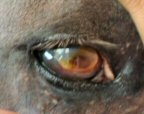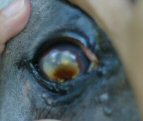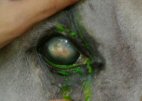Site Menu:
| This is an archived Horseadvice.com Discussion. The parent article and menus are available on the navigation menu below: |
| HorseAdvice.com » Diseases of Horses » Eye Diseases » Corneal Ulcers, Fungal and Bacterial Keratitis » |
| Discussion on Fungal Keratitis Experience | |
| Author | Message |
| New Member: Cnbreb |
Posted on Thursday, Oct 12, 2006 - 9:13 pm: I am currently six weeks into a case of fungal keratitis, with a very positive outlook and thought I could share my experience with others on the board.I have a 7 YO QH gelding who exhibited symptoms of an irritated eye the Monday before Labor Day. I cleaned the eye and flushed it with saline solution which appeared to improve the situation as the eye wasn't squinting or running the next morning. I left Tuesday afternoon for a business trip and got home Thurs to find a eye that was squinted shut and when I opened the lids I found a completely clouded eye. I had arrangements to visit with a friend over the weekend who happens to be a vet. She was willing to look at it so I brought my guy to her for the exam. Friday she found a very angry and inflammed eye which has a large superficial abrasion that was positive for stain uptake. She started him on a triple antibiotic, atropine (1x per day), miconozole and his own serum. She took a swab for cytology which showed neuroplasts, bacteria and an isolated fungal hypha. We first treated with ointments but found over the first 24 hours this was a difficult venture (most of the meds seemed to be outside of the eye). We were administering every 2-4 hours depending on the med. as a precautionary measure she also started him on oral banamine and SMZ's. A topical anti-inflamatory flurbiprofen was also administered to the eye. Saturday morning she noticed a brown pigmentation area had appeared on the cornea, but she wasn't quite sure what to make of it at that point. She recommended the insertion of an SPL (a sub-eyelid lavage system) which would insure the eye received the proper dosing of the drugs and helped keep the horse's irritation level down. She also debrided the lesion one time each day that I was there. Because of the cloudiness she had a difficult time assessing if the cause of the eye issue was primary or secondary uveitis and prepped me for the worst in case the eye didn't respond to treatment. Before I go any further, I will let you know if you encounter this disease, it will not be a inexpensive or short course of action to obtain the best prognosis. 1st week after the original notice of discomfort. I left Kim’s after four days of attentive and aggressive treatment. At this point she had conducted two cytology checks and sent a sterile sample off for lab culturing and sensitivity analysis. I was still medicating 6-9 times a day with all drugs described earlier, except orals, which were twice a day. Atropine was also administered 2 times daily. My local vet was briefed on the condition and treatment, and was willing to continue in assessing the progress. She was coming every fifth day and continued with debriding and stain evaluation. Lightning is also spending all of his time wearing a fly mask. He has minimal and supervised turnout as well. 2nd week Culture came back for two strains of bacteria that were resistant to the triple antibiotic. Changed the antibiotic to Ofloxacin (related to Cipro). Continued along the same course of action as the first week, but quit with serum. The eye was showing progression towards healing, blood vessels were appearing, and while the eye was still shut on most occasions it had quit tearing. We were sending pictures to Kim for her thoughts and the general consensus was it was healing and would just need time. There was no change in the pigmented spot. 3rd week Continued along the same track as week two; there was some talk about the possibility of cutting back on meds. The culture came back positive for fungal; Kim recommended a second culture to see if we had gotten the original infection under control. My local vet came to take the culture and evaluated the eye again, feeling we were still making good progress. We took pictures and sent them to Kim who felt the eye looked worse. After consulting with my vet, I decided to go the route of an ophthalmologist. We are fortunate that there is a local veterinary ophthalmologist in Jacksonville, FL who will also look at horses. I talked to him about our case history and offered to email pictures. He was willing to schedule us but when he received the pictures was nice enough to suggest I bypass him and go to the University of Florida instead. He was very concerned about the pigment spot which is very indicative of a fungal infection, and felt we would need all the services available at the vet school if we were to expect a positive outcome. 4th week Had a great telephone conversation with the resident vet about the possible outcomes: surgery, continued meds, enucleation. They concurred with the diagnosis, but obviously needed to do the exam to determine the course of action. They recommended upping the atropine to twice a day and eliminating the SMZs and flurbiprofen. I had been giving banamine once a day at a rate of 5ccs, UFL wanted the dosage upped to 10ccs twice a day. Made the pilgrimage to UFL. The exam showed the pigment was in fact a fungal plaque. The good news it was superficial which meant they were able to cut the plaque off the cornea under standing sedation. They sent the plaque off for culturing. Overall they were pleased it had been handled in the aggressive fashion outline so far and felt that the meds were doing their job and we should continue on that course. They also told me these things resolve slowly and can take around 6 to 8 weeks to heal. They added natamyacin to the list of meds and scheduled us for a recheck two weeks later. The med schedule for the upcoming two weeks was atropine 2xs, natamyacin, miconozole, serum, ofloxacin-all 6xs. Serum could be given more times when possible. Banamine was also continued 2xs at 10ccs, but was decreased to 5ccs both times prior to his recheck. 5th week no changes. My vet came and did recheck and stain. The eye is harder for us to evaluate because it looks so different without the plaque. It has blood vessels in the center, the peripheral edges are beginning to clear and the uptake was minimal. These are all signs that the eye is beginning to get better. 6th (and current week) We had our recheck Tuesday. The lesion, which was approx. the size of a thumbnail, is now about the size of a pencil eraser tip. The vets are very pleased and feel he will recover well and with minimal scarring. We have cut back his meds to 3 times a day and serum is being administered 4 times. Atropine had been DrOpped back to one time a day and next week we DrOp the banamine to one 5cc dose per day. I have a scheduled recheck with my vet next Weds. and go back to UFL the following week. They are extremely hopeful that the SPL will come out then. Keep your fingers crossed! I will post an update then. I will also try to post some pictures for reference... |
| Moderator: DrO |
Posted on Friday, Oct 13, 2006 - 7:28 am: Carolyn, thank you so much for this very complete report, it will surely help others with non-resolving eye ulcers. I am interested in the species of bacteria and fungi that were isolated at the various times.DrO |
| New Member: Cnbreb |
Posted on Tuesday, Oct 24, 2006 - 9:16 pm: We are now into week 8. Last week I had my vet come out to recheck and found more peripheral clearing on the edges. There was no visible stain uptake. I took pictures and sent them to the University. The attending vet was very pleased with the progress and felt we would be looking at the possible removal of the SPL or another decrease in meds.We had our appointment earlier this afternoon and they decided we could quit with the topical meds, but would continue the banamine for another 7 days to manage any inflammation. My vet is scheduled for a final check next week and provided everything continues on its current course, he is released from further treatment at UFL. The scarring should minimize and reduce somewhat significantly over the next 6-12 months. Dr. O-- The species that were found during the three cultures processed are listed below in chronological order: Bacteria Comamonas testosteroni Providencia stuartii (Both resistant to triple) Fungal Rhodotorula sp. Second culture (one week prior to UFL 1st visit) Bacteria Staph Fungal No growth UFL culture from fungal plague removed from eye Bacteria beta-hemolytic staph Fungal not included in the copy of the report I have I will try to upload some pictures. Hopefully they'll come through    September 11th September 15th   September 20th September 25th   October 4th (Post UFL) October 18th The very prominent brown spot in the pre UFL pictures is the fungal plaque. |
| Moderator: DrO |
Posted on Wednesday, Oct 25, 2006 - 12:19 pm: Thanks for the update Carolyn and the images. The Sept 20th image is particularly unusual, I have not seen a plaque that color on the eye before.DrO |
| Member: cnbreb |
Posted on Monday, Nov 12, 2007 - 12:07 pm: I thought folks might be interested in seeing how Lightning's eye turned out a year later. As bad as it looked, its hard to believe it resolved as well as it did. The scar has never caused any issues with our ridden work (i.e, no increase in spookiness or shying).  
|
| Member: pbauer |
Posted on Monday, Nov 12, 2007 - 5:58 pm: Dear Carolyn,****Very Happy For You!****  Always The Best, Tonya |
| Member: scooter |
Posted on Monday, Nov 12, 2007 - 6:08 pm: Carolyn thanks for the update and sharing your experience. Very informative! I am very glad Lightning is doing so well. |
| Member: paul303 |
Posted on Monday, Nov 12, 2007 - 7:22 pm: Many thanks for the update, Carolyn. It really does add so very much to the learning experience for us all. Besides, good news is such a pleasure! |
| Member: canter |
Posted on Monday, Nov 12, 2007 - 7:48 pm: Very glad to hear of a positive outcome! |
| Member: canter |
Posted on Monday, Nov 12, 2007 - 7:52 pm: Wanted to add a BIG kudos to you, Carolyn. Went back and re-read the whole post and I'm sure that it was a very difficult time for you but others are sure to benefit from your experience. |
Horseadvice.com
is The Horseman's Advisor
Helping Thousands of Equestrians, Farriers, and Veterinarians Every Day
All rights reserved, © 1997 -
is The Horseman's Advisor
Helping Thousands of Equestrians, Farriers, and Veterinarians Every Day
All rights reserved, © 1997 -
